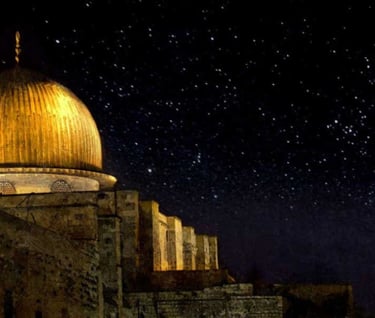Mystical Journeys


Journey Of Prophet Muhammad
By: Kai Ryn | 17/03/2025
The Mystical Night Journey of Prophet Muhammad (Isra and Mi’raj)
Mystical journeys are central to human spiritual imagination. They represent the crossing of ordinary boundaries into realms of the sacred, where the seeker encounters ultimate truth or divine presence. Among the most famous in world religious history is the Isra and Mi’raj — the mystical night journey of Prophet Muhammad. This event, deeply revered in Islam, combines themes of transcendence, divine encounter, and spiritual responsibility, and has influenced Islamic faith, literature, and mysticism for centuries.
The Isra: The Night Journey from Mecca to Jerusalem
According to Islamic tradition, the journey began in Mecca, where the angel Jibril (Gabriel) appeared to the Prophet Muhammad. He was said to be taken on the celestial steed Buraq, described as a radiant, winged creature, faster than lightning. The Prophet traveled from the Kaaba in Mecca to the Al-Aqsa Mosque in Jerusalem, a city already revered in the Abrahamic traditions. This leg of the journey, known as the Isra, symbolized the spiritual connection between the sacred centers of monotheism — Mecca, Medina, and Jerusalem.
The Mi’raj: Ascension to the Heavens
From Jerusalem, Muhammad is believed to have ascended through the seven heavens in the Mi’raj (ascension). In each heaven, he encountered earlier prophets — Adam, Jesus, Joseph, Idris, Moses, and Abraham — affirming his role as the seal of the prophetic tradition. At the highest point, he entered the Divine Presence, where he was shown realms of paradise and glimpses of the afterlife. It was here, in this ineffable closeness to God, that the command for the five daily prayers (salat) was given — an enduring pillar of Islam.
Symbolism of the Journey
The Isra and Mi’raj are not merely historical claims but carry profound mystical symbolism. The physical journey reflects the inner spiritual ascent of the soul toward divine truth. Each heaven represents a stage of purification and nearness to God. The final encounter — beyond human language or comprehension — symbolizes the unity of the human soul with its Creator. In Islamic mysticism (Sufism), this journey is often seen as a model for every believer’s spiritual path: detachment from worldly distractions, gradual ascent through spiritual discipline, and eventual union with divine love.
Historical and Cultural Impact
The event left an indelible mark on Islamic culture. The Dome of the Rock in Jerusalem, built in the 7th century, is traditionally believed to enshrine the rock from which Muhammad ascended. Art and literature across the Islamic world — from Persian miniatures to Ottoman poetry — have depicted the luminous imagery of the journey. The annual commemoration of Isra and Mi’raj is observed with prayers, recitations, and reflections, keeping the mystical essence alive in collective memory.
Comparative Perspectives
Mystical journeys are not unique to Islam; they appear in many traditions. Dante’s Divine Comedy echoes similar themes of ascent through different realms, guided by divine wisdom. Hindu texts describe Arjuna’s cosmic vision of Krishna in the Bhagavad Gita, another mystical unveiling. Yet, what distinguishes the Isra and Mi’raj is its fusion of communal obligation (the five prayers) with a deeply personal, ineffable encounter. It ties mystical experience directly to daily religious practice, linking transcendence with ordinary life.
Conclusion
The Night Journey of Prophet Muhammad remains one of the most celebrated mystical journeys in human history. Whether understood literally, symbolically, or mystically, it offers a vision of spiritual ascent, divine intimacy, and ethical responsibility. It reminds humanity that the ultimate mystical path is not only about glimpsing the divine but also about embodying that vision through compassion, prayer, and devotion in everyday life.
Coming Soon
We're on a mission ..........................

Discover our full library of The Theos e-magazines and articles — all completely free to read.
We are a crowdfunded publication, dedicated to sharing knowledge, reflection, and theology with readers around the world.
Your support and donations help us continue offering open, accessible content for everyone, everywhere.
Join us in keeping wisdom free.
@ the theos since 2023 © 2023. All rights reserved.